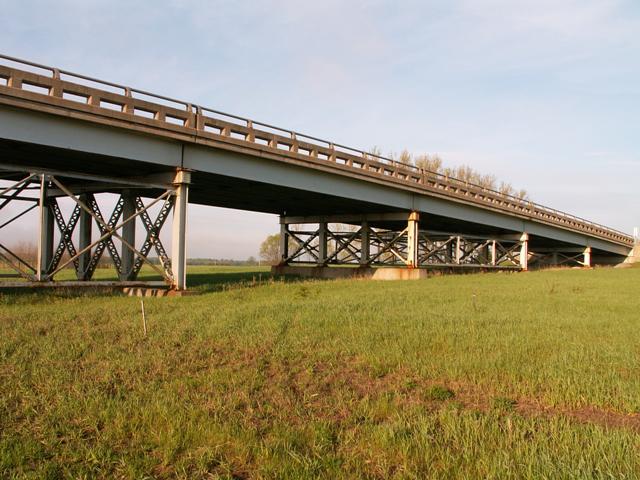We Recommend:
Bach Steel - Experts at historic truss bridge restoration.
BridgeHunter.com Phase 1 is released to the public! - Visit Now
M-48 Bridge

Primary Photographer(s): Nathan Holth
Bridge Documented: May 16, 2006
Rural: Chippewa County, Michigan: United States
1963 By Builder/Contractor: Gilliland Construction Company and Engineer/Design: Michigan State Highway Department
Not Available or Not Applicable
72.0 Feet (21.9 Meters)
673.0 Feet (205.1 Meters)
28 Feet (8.53 Meters)
12 Main Span(s)
17117033000S010

View Information About HSR Ratings
Bridge Documentation
View Archived National Bridge Inventory Report - Has Additional Details and Evaluation
This bridge is similar to the heavily modified Dafter Road Bridge, which is also only half the length of this bridge.
Although a relatively new structure to consider historic, this is a very significant bridge, for using steel stringer approach spans rather than a dirt approach, most likely due to the rocky conditions of the surrounding soil. In addition, its steel bent support design is unusual. These supports, which features rivets and v-lacing add a great deal of visual appeal to an otherwise normal stretch of rural freeway.
Most expressway bridges feature dirt approaches, where there really is no bridge, just a road running up a manmade hill. Only when it reaches the expressway is there a true bridge, where the beams carry the roadway over the expressway. With this bridge however, there are steel beams carrying the roadway not only over the freeway but also carrying the road up to its crossing elevation for the majority of the distance. Only for the first few feet does dirt provide an approach. This is unusual, and a seemingly much more costly way of building an expressway bridge was done because of the unusual soil conditions here in Chippewa County. Anyone who crosses the Mackinac Bridge into St. Ignace has seen the end of rolling dirt hills and upon entering St. Ignace, is suddenly thrust through a blasted out rocky hill before continuing north on the freeway to pass by other rocky monuments such as Castle Rock. The U.P. of Michigan is much more rocky than the rest of the state. It is likely that excavating dirt in the area of this bridge was too difficult, given the rocks that might be around this bridge. The numerous "expressway ponds" that often dot the edge of an interstate freeway show the affinity that MDOT, and the MSHD before it, had for using local dirt to build up its approaches. Although no rocks are sticking up around this bridge, there is likely a lot of rocky conditions beneath the surface layer of soil. The usual "use nearby dirt" plan did not work here. As a result, they used steel bents to support a series of steel stringer spans to produce an approach.
![]()
Photo Galleries and Videos: M-48 Bridge
Bridge Photo-Documentation
A collection of overview and detail photos. This photo gallery contains a combination of Original Size photos and Mobile Optimized photos in a touch-friendly popup viewer.Alternatively, Browse Without Using Viewer
![]()
Maps and Links: M-48 Bridge
Coordinates (Latitude, Longitude):
Search For Additional Bridge Listings:
Bridgehunter.com: View listed bridges within 0.5 miles (0.8 kilometers) of this bridge.
Bridgehunter.com: View listed bridges within 10 miles (16 kilometers) of this bridge.
Additional Maps:
Google Streetview (If Available)
GeoHack (Additional Links and Coordinates)
Apple Maps (Via DuckDuckGo Search)
Apple Maps (Apple devices only)
Android: Open Location In Your Map or GPS App
Flickr Gallery (Find Nearby Photos)
Wikimedia Commons (Find Nearby Photos)
Directions Via Sygic For Android
Directions Via Sygic For iOS and Android Dolphin Browser
USGS National Map (United States Only)
Historical USGS Topo Maps (United States Only)
Historic Aerials (United States Only)
CalTopo Maps (United States Only)

